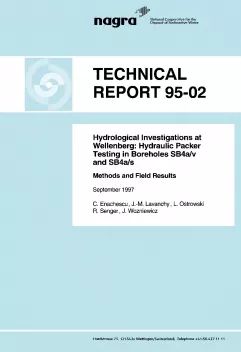
Technical Report NTB 95-02
Hydrological Investigations at Wellenberg: Hydraulic Packer Testing in Boreholes SB4a/v and SB4a/s
Boreholes SB4a/vertical (SB4a/v) and SB4a/slanted (SB4a/s) are the sixth and seventh deep investigation boreholes drilled from a single drill-site at Wellenberg as part of the Phase II investigation programme of the Wellenberg site (NAGRA, 1994). This site is under consideration as a potential location for a possible repository for L/ILW radioactive waste.
This report presents the results and describes the methods applied in the pressure transient testing of the vertical and the slanted borehole SB4a. A total of twenty three packer tests were successfully conducted in the vertical and twenty four in the slanted borehole. A primary objective of the tests was to characterise the flow properties of the formation under single and two-phase flow conditions. Of equal importance was the determination of the head distribution in the potential repository area. In general, the tests were designed and conducted in a way which allowed a flow model to be derived that accurately reflects the characteristics of the formation. Based on this flow model the effective conductivities and the heads were determined.
The downhole equipment used included single and double packer set-ups as well as special tools designed for gas injection testing and for downhole sampling. Fluid withdrawal was performed by means of a surface controlled Moineau pump system. The surface test equipment consisted of a flow control board and water/gas separation equipment. A new type of a small vertical separator was introduced. Downhole pressure data as well as surface flow and separator data were gathered by a computer-based data acquisition system.
An extended quality assurance/quality control programme was introduced and successfully applied.
Two levels of test interpretation were applied; standard and detailed test analysis. These levels were applied to both single and dual phase tests, and to gas threshold pressure tests. Test data were analysed in two steps. The first step involved using the analytical interpretation software FLowDIM and INTERPRET/2. State of the art diagnostic methods as well as careful evaluation of rate sequence and input parameters constituted the basis for an iterative analysis sequence. Based on these analysis results, consistency checks and analyses using alternative interpretation software (MULTIFIT and GTFM) were performed. For cases of two phase flow the TOUGH / ITOUGH2 codes were applied. Standard analyses were performed for all forty seven tests. Twelve tests were also analysed at a detailed level.
Interpreted hydraulic conductivities for both boreholes range from 10-13 m/s to 10-6 m/s. The head distribution confirmed the results obtained from other investigation boreholes drilled at this site. The heads were hydrostatic to slightly artesian in the upper parts of the boreholes, to about 600 m below ground level. In the lower part of the boreholes head conditions well below hydrostatic were encountered. The lowest head measured was over 600 m below ground level. The occurrence of small amount of gas in the Palfris formation and surrounding formations was again confirmed. The zones where gas was encountered were approximately between 150 m and 520 m below ground level in the vertical borehole, and between 120 m and 390 m in the slanted borehole.
